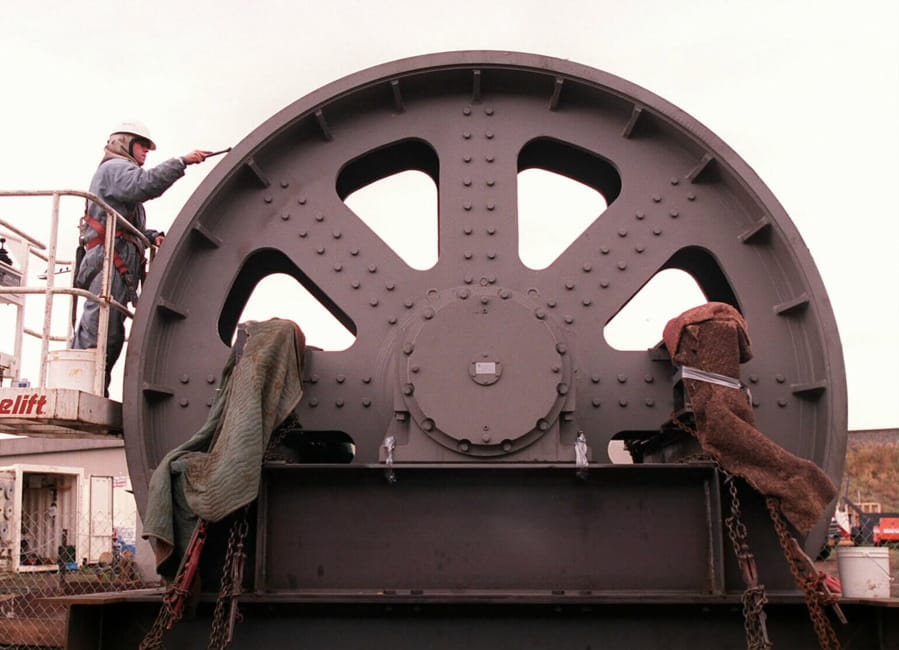Boats transported parcels from one side of the river to the other. A fatal crash snarled traffic for hours. A contractor’s speedy repair job finished the project in a third of the expected time.
September 1997 was the last time all the northbound lanes of the Interstate 5 Bridge shut down for a repair of this magnitude. While it’s happening again starting Saturday, one can only hope that the repairs will go as quickly.
It was a time with less commuter traffic: More than 50,000 commuters used the bridge in 1997, compared with roughly 72,000 today.
In 1997, the project was expected to last up to three weeks, but a speedy repair crew finished it — much to commuters’ delight — in just six days.
The Columbian, which printed in the afternoon, decided to run a special tabloid “Commuter Edition” to print in the morning and give free to travelers at Park & Ride lots, the transit mall and the Vancouver Amtrak station. Some of the trains from Portland to Vancouver were free for riders, along with the buses that carried people to downtown Portland and back.
The bridge repair and ensuing traffic drama caused some officials to predict that a sizeable number of drivers could permanently switch to alternative transportation, such as buses and trains.
Workers placed a moveable barrier to allow two lanes of traffic southbound in the morning, and they moved it to the other side of the middle lane in the middle of the day to open two northbound lanes in the evening. Even with all that, the Oregon Department of Transportation advised commuters to avoid the I-5 Bridge altogether and use the I-205 Bridge instead.
The total bill was an estimated $3 million if it went on for three weeks, which was a realistic but worst-case scenario.
Day 1, Tuesday, Sept. 16, 1997: The northbound side of the bridge closed at about 7 a.m., after the ODOT spokesperson told The Columbian: “We are ready. We are so ready.”
One clever company began a parcel ferry service to transport packages from one side of the river to the other via boat.
That morning, a song on the radio called “Ode to I-5 Bridge” by Bob Miller’s Almost All-Star Band included the lyrics, “And my commute to work is gonna last as long as the O.J. trial.”
Nobody was sure how huge of a traffic jam was about to occur, but in reality, it was quite the opposite. Roughly a quarter of commuters as usual decided to drive to work over the I-5 Bridge, making it a relatively traffic-free morning.
The only traffic jams on the first day were on the sidewalk, where TV reporters and bicyclists squeezed past each other.
C-Tran bus ridership was up 40 percent that day, and 553 passengers rode three trains from Vancouver to Portland that morning. It took 20 to 25 minutes for each train to reach Union Station.
Most drivers leaving Clark County took I-205, and many left early to avoid traffic; at 7 a.m. they could reach downtown Portland in about 25 minutes.
For Bill Niece, who lived near Vancouver Mall in 1997, his commute to Oregon Health & Science University was smooth. He and his wife, Hope Niece, who owned Hope’s Deli in downtown Portland, carpooled that morning. They left at 5:30 a.m., taking I-205, and got to downtown Portland in about 30 minutes. On their drive home, they risked taking I-5 north.
Between 3 and 6 p.m., 5,506 motorists crossed the bridge going north, which meant slow traffic but not too painful.
On the freeways that day, law enforcement chased down more than 250 HOV-lane violators and gave them tickets.
Overall, the first day went well. A Vancouver Police Department deputy chief credited the lack of traffic on the I-5 Bridge to all the advertising and news coverage about the repairs.
The weather forecast for Day 2 of the bridge closure predicted heavy rain and winds up to 40 mph. It risked a delay in work by preventing crane operators from doing their job.
Day 2, Wednesday, Sept. 17: “Despite a full moon, cloudy skies and wet pavement, the morning freeway commute was once again relatively trouble free,” according to the front page of The Columbian that day.
But over on I-205, tragedy struck.
A man died in a crash in the afternoon near the northbound Mill Plain Boulevard overpass on I-205, causing a massive traffic jam. Thirteen cars were involved in the crash, and it took troopers about two hours to clear it up. Six people were injured and sent to the hospital.
Otherwise, it was a relatively flowing day for traffic. In the afternoon, I-5 northbound traffic was backed up as far as the 78th Street exit.
On I-5, traffic was about the same on the second day, and by the end of the repair project, it would gradually creep up to about half the number of commuters on an average day in 1997.
Workers struggled to remove the 12-foot-diameter sheaves because of frozen pins that were “beyond the help of any amount of WD-40.” But workers used torches to burn the pins out of their places.
Day 3, Thursday, Sept. 18: At about 7 a.m., a six-vehicle fender bender on southbound I-5 near the 29th Street overpass caused a clogging of traffic. No one was injured, and state troopers cleared the accident in about 30 minutes.
Crews worked around the clock to haul the new 21-ton sheaves into place. Workers didn’t anticipate them to weigh so much, which caused some minor delays as they recalibrated the crane.
Overall, work was going quickly, as crews wrapped cables around the sheaves. The first tests with the cables went smoothly.
Day 4, Friday, Sept. 19: Traffic counts were up to about half the normal amount, but the freeways continued to move relatively well.
Workers made solid progress with few disruptions, and officials still thought the work would take at least a week longer.
Day 5 and 6, weekend of Sept. 20 and 21: Workers finished removing the sheaves and cracked trunnions. Each sheave-and-trunnion assembly was 12 feet in diameter.
Crews also spotted a crack under one of the 700-ton counterweights, but they said it could be easily fixed and it didn’t present any danger. Meanwhile, the last of the 32 cables were being prepped to be put in place.
Officials were hopeful that the work would be done and the bridge open for the Monday morning commute.
Day 7, Monday, Sept. 22: The day dawned with a free-and-clear Interstate 5 Bridge: workers had finished the repairs in what was called “a rapid-fire” job.
“We got it all put back together, and it still works,” said the project manager for the contractor hired to do the repairs, Christie Construction. “It went as good as anybody could have expected.”
The project was finished in a third of the estimated time. It took six days. Christie Construction of Richmond, Calif., earned a $1.5 million bonus for finishing the project faster than anticipated.
A contest hosted by The Columbian was won by Diane Valdez, who most accurately predicted the closest time for the completion of the bridge work. She won a $300 gift certificate to the Columbia Gorge Hotel in Hood River, Ore.
Then-Vancouver Mayor Royce Pollard said that the repair project “could have had very serious repercussions on our communities. It did not.”




